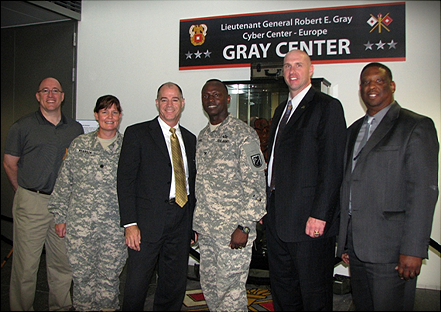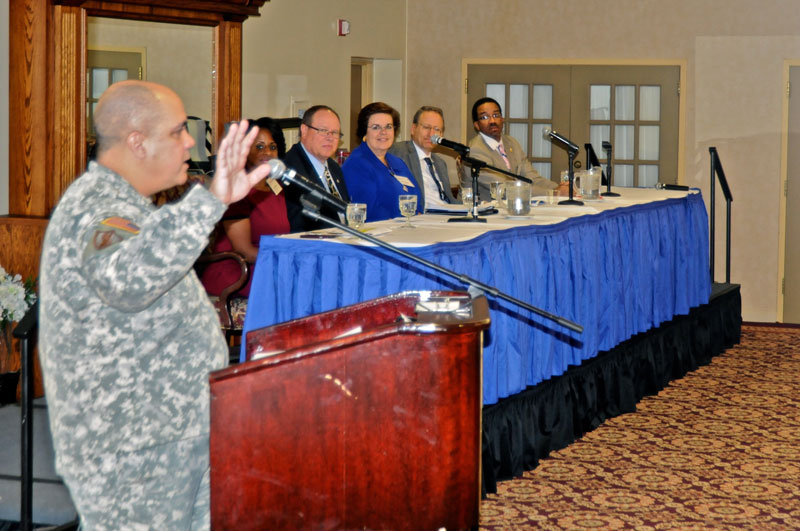News Archives
Around EIS
IPPS-A Team Golf Tournament 2014
By Andre Revell II, IPPS-A Communications Support

On Friday, 19 September 2014, over 45 members of the Integrated Personnel and Pay System-Army (IPPS-A) staff, comprised of military, civilian and contractor personnel, formed teams to compete against their colleagues in a friendly game of golf. The IPPS-A Program Management Office (PMO) hosted the IPPS-A Golf Tournament at Old Hickory Golf Course, Woodbridge, VA. The “best ball” format allowed beginning and experienced golfers to play together but still experience a sense of competition. This is the first in a series of team-building events organized by the IPPS-A leadership with the aim of networking and building camaraderie among staff.
“I witness the hard work of our military, civilian and contractor staff every day. The team is engaged and actively sharing the ideas that are going to drive this system to success. Team-building events, like the golf tournament, allow staff to take a well-deserved break and come back to work refreshed,” said COL Darby McNulty.
IPPS-A is a web-based Human Resources (HR) system, currently in development, that will provide a comprehensive personnel and pay record for each Soldier, regardless of Component. IPPS-A will alleviate the Army’s reliance on more than 40 systems that do not efficiently share information with one another. The IPPS-A implementation team is led by COL McNulty, IPPS-A PMO Project Manager, and COL Robin Parsons, IPPS-A Functional Management Division (FMD) Chief. For more information about IPPS-A, visit www.ipps-a.army.mil.
Posted November 28, 2014
PEO EIS Participates in AFCEA Belvoir STEM Day
By Ellyn Kocher, PEO EIS Public Affairs
Mr. Douglas Wiltsie, Program Executive Officer Enterprise Information Systems (PEO EIS), was the keynote speaker for the AFCEA Belvoir Chapter’s STEM Symposium Day at the Fort Belvoir Officers Club Nov 13.
Science, Technology, Engineering and Mathematics (STEM) refers to a rapidly declining skills set among the next generation of American students and future leaders, prompting education policy and curriculum choices in schools encouraging them to pursue degrees and future employment in technology fields. The STEM program embraced by government, education and industry seeks solutions to address shortages in candidates for high-tech jobs by fostering interests in STEM areas as early as elementary school, and continuing into college.
In 2006 the United States National Academies expressed their concern about the declining state of STEM education in the United States. Its Committee on Science, Engineering and Public Policy developed a list of ten actions federal policymakers could take to advance STEM education in the United States. Their top three recommendations were: (1) to increase America's talent pool by improving K-12 science and mathematics education, (2) to strengthen the skills of teachers through additional training in science, mathematics and technology, and (3) to enlarge the pipeline of students prepared to enter college and graduate with STEM degrees.
The AFCEA Belvoir STEM Symposium Nov. 13 featured a technology briefing from Mr. Wiltsie during the chapter’s monthly luncheon, and included a robotic demonstration by Fort Belvoir Elementary School students and an afternoon panel moderated by COL Robert McVay, PEO EIS Director of Cyber. The STEM panel, which was comprised of local elementary school, industry and academic leaders, discussed ideas for fostering STEM interest in K-12 and beyond.
“STEM is a vital program that reaches down to students at an early age and fosters an interest in science, technology, engineering and mathematics so that they choose related career fields as adults,” said Mr. Wiltsie of the importance of STEM. “Ms. [Heidi] Shyu and other Army and Department of Defense leaders have talked about the importance of building future leaders in technology and industry in order for the U.S. to continue to lead the pack in the fields of research and development, and in building and deploying these technologies. So the work that this chapter – and that all of you in industry – are doing to support this is important.”
Mr. Wiltsie’s command briefing at the luncheon portion of the program provided updates in the business process areas of enterprise resource planning (ERPs), network modernization, biometrics, medical, and general technology updates, as well as upcoming procurement opportunities, and included the premier of the new command video, which can be viewed on the PEO EIS website.
The AFCEA Belvoir Chapter has a history of robust STEM support, sponsoring scholarship programs at local schools and hosting regular demonstrations and STEM Days to promote industry and community awareness. PEO EIS has been actively engaged in AFCEA Belvoir STEM events in recent years, sending representatives from Product Director Defense-Wide Transmission Systems (PD DWTS), Project Manager DOD Biometrics, and the Product Director Automated Movement and Identification Solutions (PD AMIS) to demonstrate their programs’ technologies at STEM Days at local K-12 schools.
More information about AFCEA Belvoir’s STEM program and photos from the event can be found on the PEO EIS website, and at www.afceabelvoir.org.







Posted November 17, 2014
PdM P2E Team Completes Gray Cyber Center Project, Wiesbaden, Germany
By Courtney Cashdollar, P2E Public Affairs support
 Mr. Daryle Sewell, PdM P2E Europe SETA Support and QBE Sr. Program Manager; LTC (P) Mollie Pearson, Product Manager, PdM P2E; Mr. Douglas Wiltsie, Program Executive Officer, Enterprise Information Systems (PEO EIS); COL Jimmy Hall, Jr., Commander, 5th Signal Command; Mr. Tom Dunaway, Director, PdM P2E Europe Directorate; and Mr. Albert Adams, WIPC IPT Lead and Deputy Project Support Officer, PdM P2E Europe.
Mr. Daryle Sewell, PdM P2E Europe SETA Support and QBE Sr. Program Manager; LTC (P) Mollie Pearson, Product Manager, PdM P2E; Mr. Douglas Wiltsie, Program Executive Officer, Enterprise Information Systems (PEO EIS); COL Jimmy Hall, Jr., Commander, 5th Signal Command; Mr. Tom Dunaway, Director, PdM P2E Europe Directorate; and Mr. Albert Adams, WIPC IPT Lead and Deputy Project Support Officer, PdM P2E Europe.The Product Manager, Power Projection Enablers (PdM P2E) team completed the Gray Cyber Center project in Wiesbaden, Germany on October 30, 2014. PdM P2E worked extensively with the 5th Signal Command in the development and implementation of the information technology (IT) infrastructure portion of this 52,000 square foot facility named in honor of the late Lt. Gen. Robert E. Gray, a former United States (US) Army Signal Officer.
German and American officials broke ground for the Gray Cyber Center in June 2012 with 5th Signal Command slated to oversee the entire project, including the IT infrastructure portion. Approximately one year into the project, 5th Signal Command realized the magnitude of the effort and engaged PdM P2E to manage the $6.16 million IT infrastructure project to engineer, furnish, install, secure, and test (EFIS&T) a Command, Control, Communications, Computers, and Intelligence (C4I) system for the Cyber Center.
The resulting facility, located at Clay Kaserne in Wiesbaden, Germany, consolidates tactical, theater and strategic communications functions in support of U.S. European Command (EUCOM), U.S. Africa Command (AFRICOM) and U.S. Army Europe (USAREUR). This complex facility system now manages all services networks to greatly enhance cyberwatch oversight complexities from the Stuttgart-based European Command and serves as the network and communications provider for over 40,000 users in Europe.
This state-of-the art building encompasses the latest in modern technology and is expected to significantly expand its scope of activity in the coming years.
Regardless of the short timeline from the January 29, 2014 contract award date through the projected completion date of October 30, 2014, the serious threat to the building occupancy date (BOD) that could have cost the Army millions of dollars, and numerous other obstacles that were beyond P2E’s control, the team remained aggressive and developed a course of action that allowed the team to achieve Full Operational Capability (FOC) on August 21, 2014.
The completed project includes:
- Support for over 350 users with Non-Secure Internet Protocol Router (NIPR), Secure Internet Protocol Router (SIPR), Battlefield Information, Collection, & Exploitation System (BICES), Combined Enterprise Regional Information Exchange System (CENTRIXS)-ISAF (CX-I) and Joint Worldwide Intelligence Communications System (JWICS) Networks
- Voice over Internet Protocol (VoIP) Capability for over 350 users
- Digital Media Suite with: Internet Protocol Television (IPTV), Video Teleconference (VTC) central bridge and Audio/Visual room digital matrix switching capabilities
- Theater Combined Operations Information Center (TCOIC) video wall, two large VTC rooms, 1 Medium VTC,1 Small VTC and 10 SIPR Telepresence units
PdM P2E has enabled 5th Signal Command the ability to shield its computer networks throughout Europe and parts of the Middle East and strengthen theater strategic and tactical communications gathering sustaining future missions of EUCOM, AFRICOM and USAREUR. This newly constructed building represents the latest technology, which is expected to significantly expand its networking capacity of activity in the upcoming years.
Mr. Albert Adams, PdM P2E Integrated Project Lead, successfully managed this project with supporting leadership from Mr. Michael Moseley and Mr. Tom Dunaway (PdM P2E Europe Directors), and LTC (P) Mollie Pearson, the Product Manager for PdM P2E. The 5th Signal Command is extremely satisfied with the facility and they are already using it to support Soldiers across the world!







Posted November 10, 2014
CHESS Provides Program Update at AFCEA ITES-3S Matchmaking Event
By Joanna Corcoran, Public Affairs support, PD CHESS
On October 28, Project Director Tom Neff, Computer Hardware Enterprise Software and Solutions (CHESS), presented an ITES-3S program update at the AFCEA Belvoir Matchmaking Event. The AFCEA Belvoir Matchmaking Event gives small businesses the opportunity to network with contract primes. Over 200 industry personnel and 21 companies were in attendance.
Mr. Neff provided a brief overview of ITES-3S, including planned scope, period of performance of a five-year base and one four-year option, and task areas. Task areas for ITES-3S include Cyber Security Services, Information Assurance and Information Systems Security, Information Technology Services, Business Process Reengineering, Enterprise Design, Integration and Consolidation, Network/System Operation and Maintenance, Telecommunications/System Operation and Maintenance, IT Supply Chain Management and IT Education and Training.
The ITES-3S restricted suite will be awarded to the top 14 small business contractors, and the unrestricted suite will be awarded to the top 10 contractors regardless of size. The contract ceiling for ITES-3S is $9.5 billion. FedBizOpps will be the method of notification for releases such as (but not limited to): industry day, draft performance work statement, draft Sections L and M, draft solicitation and final solicitation.
Please continue to monitor FedBizOpps for any releases or updates to this acquisition. Meanwhile, Army Contracting Command - Rock Island will be working an extension for ITES-2S. For additional questions about CHESS and its programs please visit the CHESS IT e-mart at https://chess.army.mil or contact Customer Support at 1-888-232-4405.
Posted November 10, 2014
MC4 Receives AMSUS Award
By MC4 Public Affairs
FORT DETRICK, Md. – Medical Communications for Combat Casualty Care (MC4) has been selected as the 2014 recipient of the AMSUS (The Association of Military Surgeons of the United States), The Society of Federal Health Professionals, Operational Medicine Award. MC4’s electronic medical record (EMR) 2.2.0.0 integrated product team receives this award for its leadership and accomplishments in overcoming extraordinary challenges to upgrade the Army’s deployable EMR system while maintaining mission performance. The award also recognizes MC4 for its significant accomplishments, evidence of mission support, demonstrated professional and technical performance and innovative and creative practices.
“MC4 is extremely proud and honored to be recognized by AMSUS with this award,” said MC4 Product Manager Lt. Col. Danny J. Morton. “Our MC4 EMR 2.2.0.0 integrated product team, as well as all MC4 employees, are committed to providing excellent customer service, considering new technologies and staying focused on the mission, which is ensuring that our soldiers have a secure, accessible, lifelong electronic medical record. This award is testament to that commitment.”
MC4 is the Army’s deployable EMR that captures health information for soldiers when they receive care in deployed environments, and provides medical professionals on the battlefield the capability to record soldier care, enabling improved medical decisions during all stages of the continuum of care. The system also provides commanders medical situational awareness regarding injuries and disease control, enabling them to assess unit readiness and automate medical logistics.
MC4 helps ensure that soldiers have a secure, accessible EMR that goes with them long after completing their service to our nation—providing soldiers with peace of mind that their medical data will be accessible when they apply for benefits.
“MC4’s ability to successfully complete the MC4 EMR 2.2.0.0 software upgrade within the shortest period of time in the history of the program was the culmination of good team work,” said Lt. Col. Keith G. Harley, MC4 assistant product manager and project lead integrator. “We were able to prioritize resources and efforts, as well as leverage the abilities of individual team members, resulting in upgrades to more than 3,500 active MC4 systems.”
About MC4
MC4 integrates, fields and provides technical support for a comprehensive medical information system enabling lifelong EMRs, streamlined medical logistics and enhanced situational awareness for Army operational forces. MC4 is an acquisition program of record located at Fort Detrick, Maryland, and is overseen by the Program Executive Office Enterprise Information Systems (PEO EIS), Fort Belvoir, Virginia. For more information, visit www.MC4.army.mil.
Posted November 06, 2014
CSS VSAT Critical to AFRICOM Response
By Paul Tremblay, DCATS Public Affairs
PEO EIS-provisioned Combat Service Support (CSS) Satellite Communications (SATCOM) Very Small Aperture Terminals (VSATs) are being shipped to West Africa in support of U.S. government efforts to contain the spread of the Ebola virus, which has infected and killed thousands in Guinea, Liberia, Nigeria, and Sierra Leone.
The U.S. military has quickly established the Joint Forces Command – United Assistance (JFC-UA) to support the comprehensive U.S. government response to the Ebola outbreak. United States Agency for International Development (USAID) is the lead U.S. agency in charge of the U.S. response to the Government of Liberia’s request for assistance in containing the Ebola Virus Disease. The mission of JFC-UA is to oversee the construction of and facilitate staffing for healthcare facilities needed to contain the outbreak, such as a 25-bed treatment facility dedicated to treat healthcare workers who may become ill while treating Ebola patients.
U.S. Africa Command (AFRICOM) is drawing resources for this mission from:
- 101st Sustainment Brigade and the 86th Combat Support Hospital, Fort Campbell, Kentucky
- 7th Transportation Brigade, Fort Eustis, Virginia
- 1st Medical Brigade, Fort Hood, Texas
Soldiers will not be treating Ebola patients directly; rather, they will provide training to on-site healthcare personnel, and infrastructure and testing support in the form of modular Expeditionary Medical Support Systems.
As many as 4,000 personnel are being rapidly deployed for this humanitarian mission to a remote location with many critical elements. One of those elements is the CSS VSAT, which will constitute the operation’s primary SATCOM sustainment link with the rest of the world. Chief Warrant Officer 2 (CW2) Jonathan M. Griffin, Signal Corps Information Systems Technician for the 101st Sustainment Brigade, explains the criticality of the VSAT team’s mission. “I mean ‘critical’ as in we cannot succeed at this mission without it. Without it, we cannot communicate, we cannot keep ourselves supplied, we cannot maintain the equipment that we have. No VSAT, no mission.”
Approximately 20 CSS VSAT units will be deployed in support of this operation. As a member of Product Director Defense Wide Transmission Systems (PD DWTS), Contractor Field Service Representative Emmanuel “Mikey G.” Gerogianis and other U.S. contractors are working extraordinarily long hours to prepare these systems for deployment.
These teams are upgrading units to include the new e800 modem and replacing 4-watt block up-converter (BUC) transmitters with 6-watt BUC transmitters to provide the additional power to reach satellite assets in that part of the world, which orbit at relatively higher altitudes. They are configuring the CSS VSATs to work on the Defense Communications and Army Transmission Systems (DCATS) Communications Network (DCN) T11N network, which provides coverage across West Africa.
Posted November 06, 2014






